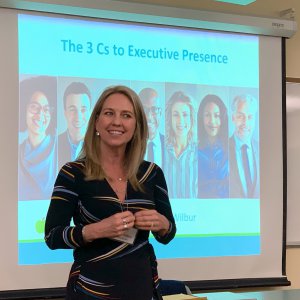By HOPE RUDZINSKI
DUDLEY, Mass.—Executive presence is rated as the most important skill to be an effective leader. It’s the ability to exude a sense of gravitas—confidence, decisiveness, dignity, and poise. First impressions matter, in and out of the workplace. Therefore, it’s the difference that makes you memorable for the right or wrong reasons. And, if you want to move up the corporate ladder, you need the soft skills that are part of the executive presence package.
In other words, executive presence is a game changer.

Diane Wilbur
“It’s hard to define, but you know it when you see it,” Rhode Island-based body language coach Diane Wilbur, CEO of Soft Skills Training Group LLC, told Nichols College students, faculty, and staff Feb. 13, 2019, during her interactive workshop “Developing Your Executive Presence.”
The session was offered in Davis Hall by the Nichols Fischer Institute, Institute for Women’s Leadership, and the Emerging Leaders Program. It was a fitting offering, too, since Nichols is a college of choice for business and leadership education, and it transforms today’s students into tomorrow’s leaders through a dynamic, career-focused business and professional education.
A polished speaker with effective executive presence, Wilbur coaches executives, facilitates communication workshops, and works with professionals to develop leaders and guides them on how to command a room with confidence. She said that the three main elements of executive presence are character, confidence, and communication.
Often, an organization’s Human Resources staff want to know who is on the edge of becoming the next leader. While a candidate may look fantastic on paper, senior leaders “have this feeling that whatever it is, [the candidate] just doesn’t have it,” she said. “But when you walk into the room, you know it when you see it.”
She introduced to the group the “7-11 Rule”:
“Within the first seven seconds of meeting a new person, we make 11 assumptions about them—from their appearance to the way they speak and interact,” said Wilbur.
Her workshop with Nichols students was interactive. Wilbur had her audience of male and female students stand up several times and shake each other’s hands to test whether their handshake was firm or weak. She explained that a handshake could make or break how someone else views you and is the starting point of that connection with the other person. One always has the exit handshake, however, to make up for the first and thus have that person reevaluate you—hopefully.
“Handshakes matter,” Wilbur said. “Meaning, how you execute your handshake is very important when meeting someone.
“When you have an opportunity to shake someone’s hand, take it; you’ll become more memorable,” added Wilbur.
This is an important point to realize when you are meeting someone for the first time, as people tend to judge others too much, and they don’t realize they do it, she explained.
Executive presence shows up everywhere, according to Wilbur.
“It’s all about your intention and how you apply it that makes a difference,” she said. “Executive presence is rated as the most important skill to be an effective leader, surpassing technical and functional expertise.
“It’s how you make people feel,” Wilbur added. “So, show up as the best version of yourself.”
Gender also plays a role in executive presence, because with it comes along different perceptions.
“A boss told me one time when we were interviewing new candidates for a position that this particular woman couldn’t get the job, because she didn’t have what it takes—even though I wanted to hire her,” said Wilbur. “She had everything: a perfect resume, confidence, etc.”
In the workplace, men are perceived to have more confidence than women, while women are thought to have more poise, Wilbur shared, noting that these are qualities that are expected and brought on by society. She added that women are taught and/or looked at to be quiet; men are pressured to have confidence and to land every job offer.
Body language is 60 percent of your message.
“It’s so powerful,” said Wilbur. “It’s the main message of what we’re saying, how we feel, and how engaged we are in a conversation.”
Wilbur taught the Nichols students how to be a different leader and to read various signals in the workplace. The students gained valuable knowledge about how to look beyond gender differences in the workplace, to develop their own executive presence, and to become the best leader they can be.
“First impressions matter as much as the last impression. Make it count,” she said.
Hope Rudzinski is a junior English major at Nichols College and a public relations intern for the Nichols Office of Marketing and Communications.
TIPS FROM DIANE WILBUR:
- Avoid using these words: only, just, sort of, in my opinion, maybe, I guess;
- Avoid “upspeak” (turning statements into questions);
- Hands are trust indicators: If you don’t know what to do with your hands, put them at your side or make a steeple gesture (shows confidence and that you are engaged);
- Keep eye contact 60-70 percent of the time; otherwise, look at the other person’s forehead in a professional scenario and at the cheeks level in a social situation;
- If you want to build rapport with someone, mimic what they are doing;
- “The Belly Button Theory”: If one’s belly button isn’t facing you, that person is ready to leave the conversation;
- Sit in the middle, or at the head of the table.
